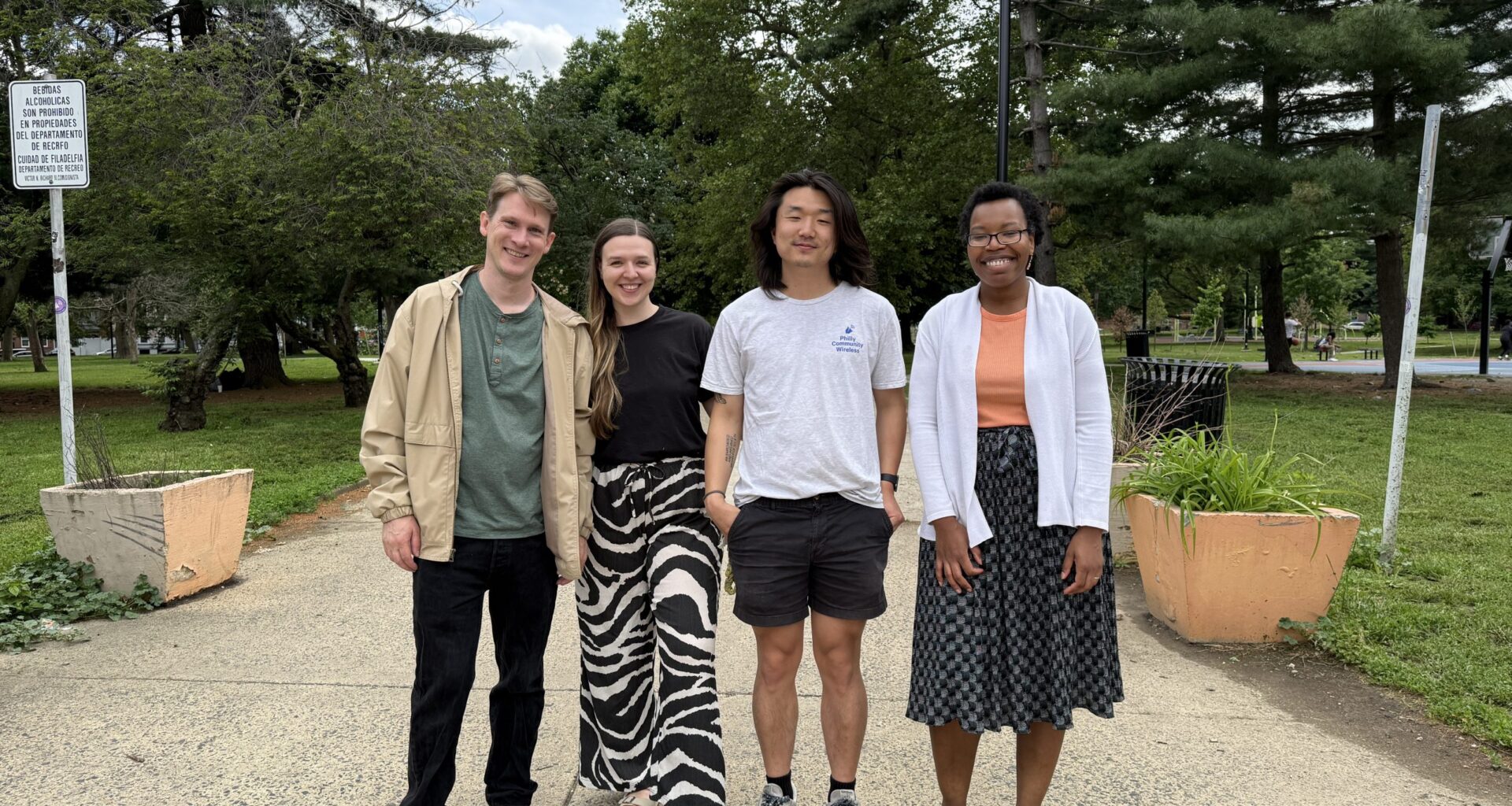Connecting communities is something that Alex Wermer-Colan, the executive director of Philly Community Wireless, is passionate about. His organization’s mission is to equip as much of North Philly with free WiFi as it can.
“We are trying to build a large-scale network that’s shared by the community,” he said. “That might mean that your house is sharing WiFi with your neighbor, and that if you live in the house, you may be able to connect to our network and walk around the neighborhood without ever getting disconnected.”
The program has a unique focus, and has seen some major successes.
Wifi providers often concentrate on indoor connectivity and ignore the outdoors. Philly Community Wireless focuses on filling in the gaps between indoor internet in various buildings. This means equipping local parks, community streets and gardens with free wireless networks.
Philly Community Wireless is located in Norris Square Park. Billy Penn recently got to tour their existing infrastructure, and see why its organizers call these services a vital right.
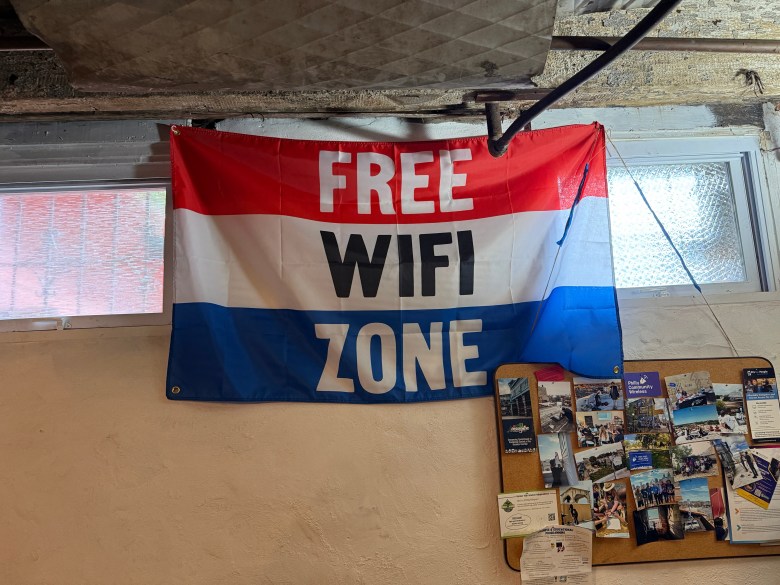 The organization’s basement offices contain lots of setup equipment and encouraging signs (Violet Comber-Wilen/Billy Penn)
The organization’s basement offices contain lots of setup equipment and encouraging signs (Violet Comber-Wilen/Billy Penn)
The process
Part of the organization’s success depends on access to the properties around public spaces. In order to work properly, equipment is built on a “line of sight” plane between the rooftops of different buildings. Oftentimes, that means getting permission from owners of these buildings to get up on the roof, said Leanne Przybylowski, community outreach manager at Philly Community Wireless.
She mentioned the cooperation of a local restaurateur, who owned a building that sat in the perfect location to extend wifi network to the surrounding area.
“So he said yes to providing internet access for his neighbors and for this community in general, even though we weren’t able to provide it inside for him because he has a business,” Przybylowski said. “So that’s an example of, you know, a community member who is willing to use their resources, or their property, in this case, to provide for the rest of the community, which is great, right?”
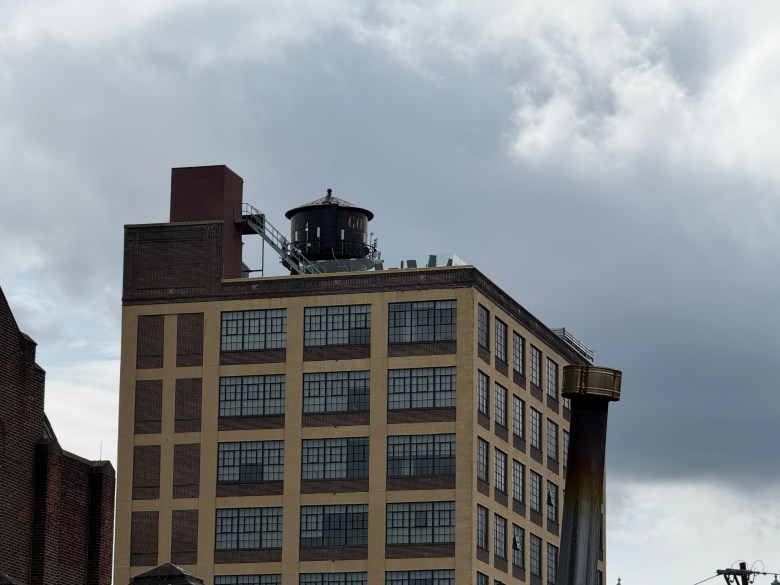 While devices are sometimes too small for the eye to see, rooftops like the one on this building in North Philly, can contain “line of sight” connectivity devices that connect the surrounding area. (Violet Comber-Wilen/Billy Penn)
While devices are sometimes too small for the eye to see, rooftops like the one on this building in North Philly, can contain “line of sight” connectivity devices that connect the surrounding area. (Violet Comber-Wilen/Billy Penn)
Wermer-Colan explained that coverage often requires cooperation between residents, and that he is “surprised by how many people will say yes” to requests to use their building to host equipment.
The technology is “modular,” meaning it is easier to install than standard internet cables, said Eugene Ryoo, a technician for Philly Community Wireless. “The footprint is very small,” he said. “If we really needed to, we could go up there and take all that down in two hours or three hours, and we wouldn’t have to tear up the street.”
Around the perimeter of Norris Square Park, there are various Philly Community Wireless devices. Some are lodged in third-story windows or on rooftops of local businesses, while others are perched on the side of a building or a rooftop garden. This allows the devices to work together to provide continuous coverage of an area.
The need for outdoor internet
The internet is an essential tool for work and school, and access is important outdoors as well as indoors, Przybylowski said.
“I never thought about the internet as something that could spread between walls, but obviously it can,” she said. “Why would it be restricted by four walls? I think we have this idea of ‘you’re in a private space, and the internet for that space is just in that space, and it can’t go anywhere else.’ And that’s not accurate at all.”
For people experiencing homelessness or without stable housing, outdoor wifi can be the only option.
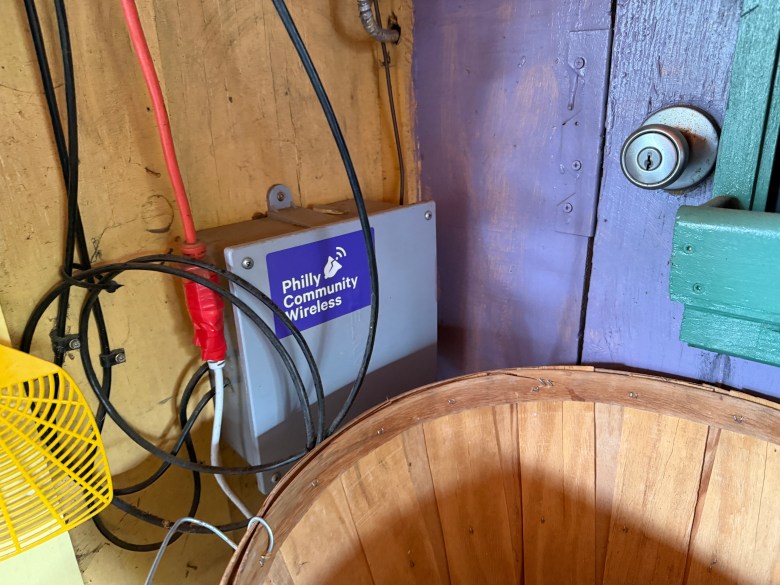 The organization has many kinds of outdoor infrastructure that can handle weather wear and tear. (Violet Comber-Wilen/Billy Penn).
The organization has many kinds of outdoor infrastructure that can handle weather wear and tear. (Violet Comber-Wilen/Billy Penn).
This can be especially important for youth, said Xena Stearos, the coordinator for Norris Square Neighborhood Project, which provides after-school and summer programs, including community gardens, for local youth.
“I always think of it in terms of the youth we serve and the people who are working in our gardens or hang out in the spaces around our gardens, and how that is available for maybe completion of homework or the ability to look something up or contact somebody if needed, if you don’t have your regular cellular service,” she said.
She explained wifi is especially important for schoolchildren who may need to fill out forms or complete tasks via the internet, even when hanging out outdoors.
“We’re in a time where wifi is a necessity,” she said. “It’s not just a want to be able to get access to certain forms if you need help with things and you don’t have an active resource who could print them for you. Being able to have wifi to look those things up online or fill out different applications, it’s beneficial and a need.”
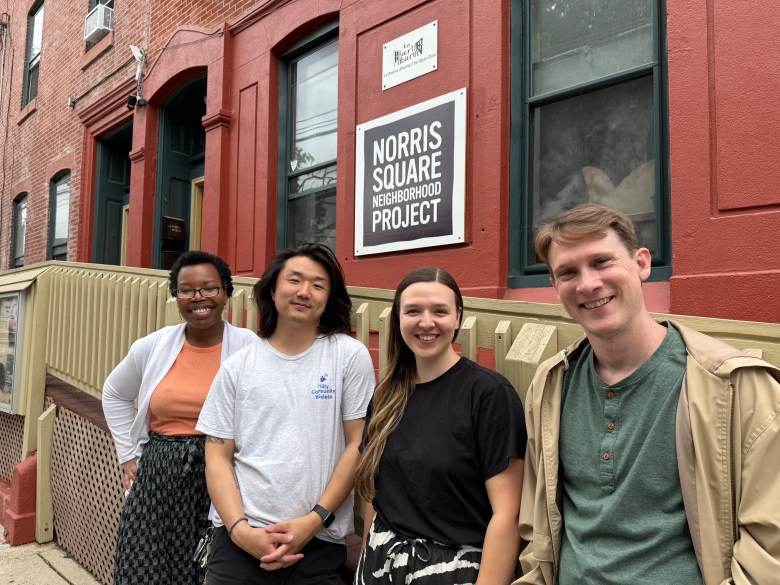 Philly Community Wireless leaders work out of the Norris Square Neighborhood Project — which offers vital community resources for the surrounding neighborhood. (Violet Comber-Wilen/Billy Penn)
Philly Community Wireless leaders work out of the Norris Square Neighborhood Project — which offers vital community resources for the surrounding neighborhood. (Violet Comber-Wilen/Billy Penn)
Piloting the program in this neighborhood has been helpful to the surrounding community, said Andria Bibiloni, the executive director of the Norris Square Neighborhood Project.
“We were working with communities where all of our youth are eligible to receive free school lunch,” she said. “Most of them do have cellphones, but they’re on their parents’ plans or whatever. And there are a lot of seniors also in our community who might not otherwise have access. So I think piloting this here and making it available here is just something that makes the internet more accessible to people when it otherwise would be a challenge.”
She said she hopes to see this program expand to other areas.
Being connected everywhere is a need in this day and age, said Sascha Meinrath, the Palmer Chair in Telecommunications at Penn State University and an expert in broadband.
“It’s not just about being able to buy cheap diapers and get plane tickets fast,” he said of internet access. “It’s about applying for jobs, paying taxes, and being connected to a social life. In essence, it’s about the quality of life, economic activity and education, and this
Meinrath emphasized not having internet or accessibility in and around a home can also devalue it.
“If you don’t have connectivity, your house is worth less, so you’re accumulating less wealth in that domain,” he said. “Data has shown that it costs a household somewhere around $1,500 a year to not be online, which is to say this really translates to a pocketbook issue as well as a general quality of life issue.”
The wifi network can be used in ways beyond Googling a trivia question, Przybylowski explained. It can improve community wellness.
“Another device that we’ve installed is called a purple air monitor,” she said. “So, a purple air monitor, very clearly monitors and tells you if it is safe to be outside. Also, it provides data around air pollution.”
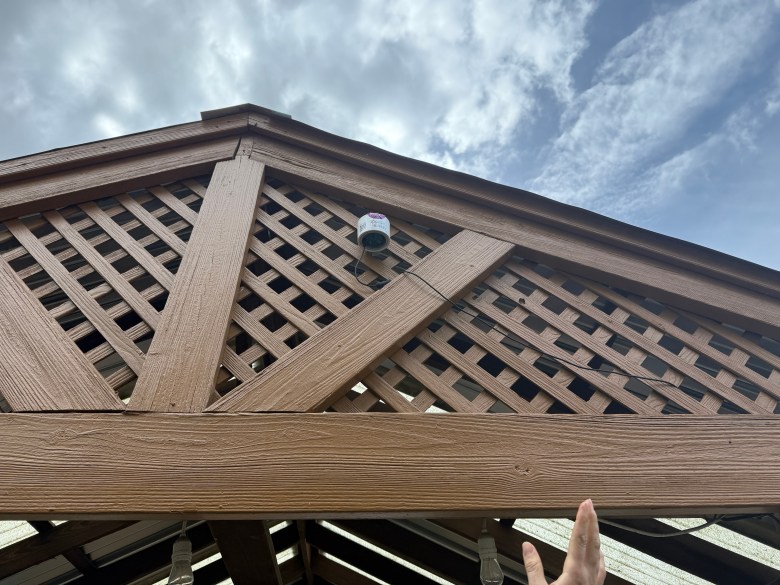 The organization’s purple air monitors are an example of devices that can help the environment, but require WiFi connections (Violet Comber-Wilen/Billy Penn)
The organization’s purple air monitors are an example of devices that can help the environment, but require WiFi connections (Violet Comber-Wilen/Billy Penn)
These devices are part of what’s called the “internet of things”, or IOT, meaning measurement devices that report conditions to a central database.
Another unexpected feature of the Norris Square network? Art. Individuals can scan a QR code to view an interactive exhibit.
“So with a particular app on your phone,” Przybylowski said, “you can scan these photos, and then what will pop up is a video, and it’s the people in the photos, storytelling and sharing something that’s important to them or something that’s relevant to their cultural experience here in Philadelphia, or here in the garden or things like that.”
The problems
Philly Community Wireless is covering parts of Kensington, but they can only do so much, so fast, said Wermer-Colan.
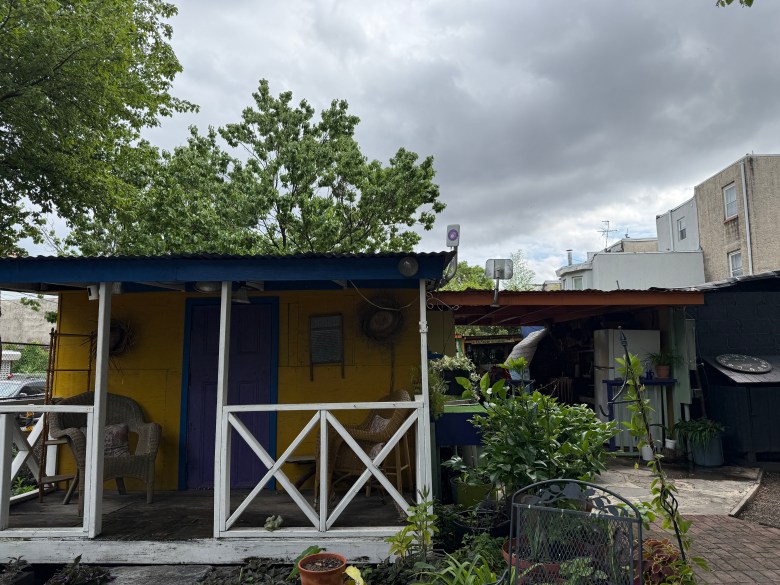 Philly Community Wireless equips many parts of North Philly, including the community gardens around Norris Square Park, with connectivity (Violet Comber-Wilen/Billy Penn)
Philly Community Wireless equips many parts of North Philly, including the community gardens around Norris Square Park, with connectivity (Violet Comber-Wilen/Billy Penn)
“Our biggest problem is actually the demand for this work and for this connectivity far outstrips our capacity to provide those services,” he said.
The biggest challenge in expanding these kinds of programs is lack of resources, Meinrath said. Speaking to the Billy Penn team from D.C., where he was advocating for resources for increased broadband resources, he said federal and state governments have also been slow to invest in appropriate resources.
“Almost every other highly industrialized nation is investing heavily in bridging the digital divide,” Meinrath said. “Why the United States is spending time and energy to rescind the marginal successes that we have had, that’s mind-boggling to me.”
He said the U.S. has continually made its digital divide bigger, while other countries are closing theirs.
Another challenge, Meinrath explained, is the lack of data around internet challenges in the community.
“Within the Philly Community Wireless project, we are serving a community that is systematically and consistently, year after year, underserved,” he said. “And according to official measures, [that problem] simply doesn’t exist. So it’s very difficult to address a problem you don’t acknowledge as existing in the first place.”
According to the city’s most recent data, there are still many households that don’t have any type of broadband access. In 2019, 84% of households had “broadband of any type” – which includes services such as cell service or satellite. This means that 16% of Philadelphians are living without broadband of any type.
Meinrath emphasized more coherent national and statewide policies would be helpful to addressing this problem.
Even so, Wermer-Colan said the city has consistently been supportive of the program.
“The city has supported us from the beginning,” he said. “The first grant we received was from the Digital Literacy Alliance in 2021 and they provided us a grant for engaging with immigrant communities and second language English learners. And our goal was to start building out this pilot project in Norris Square, and since then, we’ve regularly partnered with the city.”
However, he explained state laws can often limit what can be done to establish further connectivity.
“One piece of important context is that in Pennsylvania, it is illegal for the city to build a municipal internet network,” he said. “There are 20 states across the country where there are laws in place that block cities from building public internet. That is not the city’s fault. That is not a just law. It should not exist.”
The 2004 Pennsylvania law that made it harder for cities to establish their own high-speed Internet networks is still in place today. The law essentially made it harder for city networks to compete with the city’s dominant telecommunications providers. This can complicate the establishment of streamlined services.
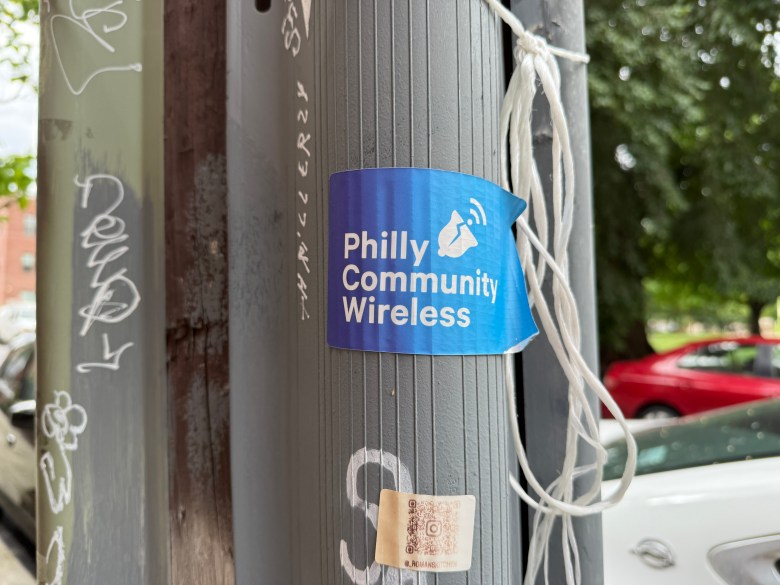 Philly Community Wireless aims to expand Internet services as much as possible, despite sometimes stringent state laws (Violet Comber-Wilen/Billy Penn)
Philly Community Wireless aims to expand Internet services as much as possible, despite sometimes stringent state laws (Violet Comber-Wilen/Billy Penn)
Wermer-Colan explained expanded phone service can be an important component of increasing access to services. However, he said the work phone companies may do to establish further services and wireless can still leave out the outdoor capabilities PCW works hard to provide.
“Verizon is going to be providing internet to all of Philadelphia’s parks and rec centers,” he said. “But there’s a really important caveat to that plan, as I understand it. They are not providing outdoor internet. They are only doing internet inside the park and rec center. Our whole thing is people need outdoor internet. They need to be able to access internet from the park. What if another pandemic happens and you can’t go inside the building?”
The future
Philly Community Wireless and community partners alike are hopeful that this project can expand beyond the neighborhoods where it started. But, as Wermer-Colan explains, installing wifi outdoors is complicated. It can require accessing multiple properties and getting up on rooftops of private businesses – which can take a lot of coordination.
“A lot of our work is about negotiating with real estate orders, and oftentimes we’re installing at a location, like where somebody lives, and it’s their only property,” he said. “So we make some progress, but it’s not like they can give us access to 10 more properties.”
Wermer-Colan said a big part of expansion would be further access to property, which the city could help with.
“Nobody owns more property distributed across the city in a consistent manner than the city,” he said. “We don’t charge anything of the community and we also are not prepared to pay for access to real estate, for the same reason. We are a completely charitable organization. If the city were to say to us, ‘You can leverage every parks and rec center to build out outdoor wife.’ If they were to say to us, ‘You could use the SEPTA Rail line in Kensington to build out your wifi,’ it would completely transform the organization’s capacity.”
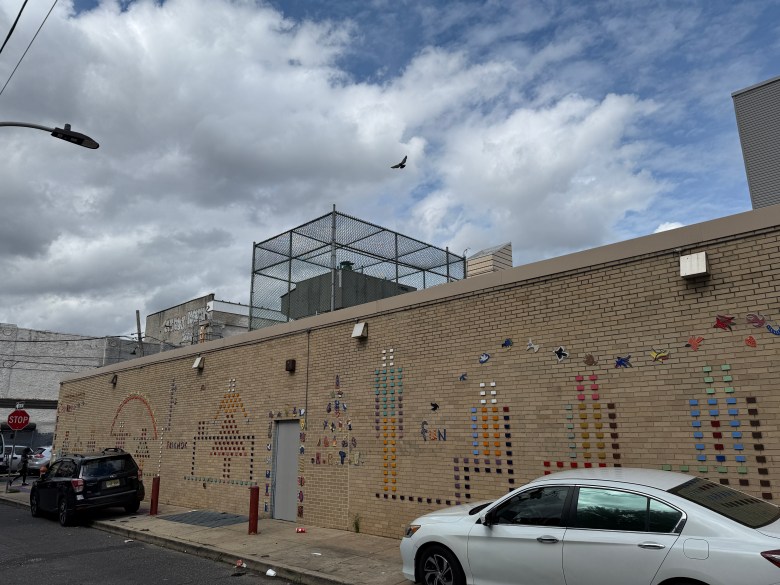 Philly Community Wireless helps to equip areas around The Kensington Public Library with WiFi, along with other community organizations (Violet Comber-Wilen/Billy Penn)
Philly Community Wireless helps to equip areas around The Kensington Public Library with WiFi, along with other community organizations (Violet Comber-Wilen/Billy Penn)
While people may view Philly Community Wireless as a tech organization, Przybylowski explained it is providing much more.
“It’s a lot more than just tech, right?” she asked. “We’re building a community resource that can then facilitate other community resources that can help invest in existing communities in ways that they haven’t been able to do without the public internet or open internet that’s available for everybody.”
PCW’s services are available to residents in the North Philadelphia neighborhoods of Fairhill, Kensington, and Norris Square. They can request free wireless setup or volunteer to host an antenna to connect their neighbors or learn more about Philly Community Wireless’s connection process.
